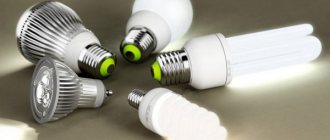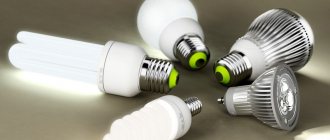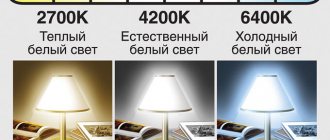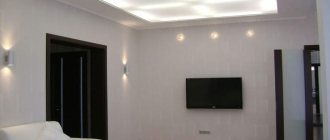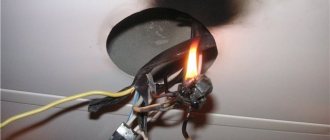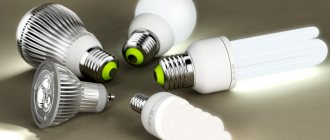Quite recently, my electrician friend told me about the advantages, disadvantages and rules for choosing energy-saving lamps. He said that these bulbs consume much less electricity than regular ones. What types of “housekeepers” there are and what you need to pay attention to in the process of choosing them in order to reduce costs, I will tell you in the article.
Energy-efficient (energy-saving) lamps are electric lamps that are endowed with significantly greater light output (the discrepancy between power consumption and light flux) compared to typical light bulbs.
“Economy lamps” convert all the energy used into light, while simple ones transform only 10-15%, and the remaining 85-90% of the energy is used to produce heat. That is, significant energy savings occur here.
There are three types of energy lamps:
Fluorescent lamps
A fluorescent lamp is a bulb with electrodes made of tungsten. In this flask, an electric discharge creates ultraviolet radiation in mercury vapor, which, with the help of a phosphor (a substance capable of converting the energy it absorbs into light), is transformed into visible light rays. For example, a mixture of calcium halophosphate with other substances can be used here.
Advantages of fluorescent lamps:
- 5 times less energy is used than simple lamps (a 20-watt fluorescent lamp is identical to a classic 100-watt lamp);
- have a long service life - from 7,000 to 10,000 hours;
- provide excellent lighting, the light can be yellow (warm) or daylight (white).
- they contain mercury, which makes them permissibly dangerous, and therefore require careful handling and specific disposal;
- the fluorescent lamp lights up with a delay of 0.5-1.5 seconds, the brightness increases imperceptibly;
- sometimes they flicker, which creates discomfort for the eyes;
- the service life of such lamps depends on the number of starts and is about 5 years, provided that the number of starts is localized to 2000, that is, no more than 5 times a day for two years (warranty period);
- the brightness of such light bulbs gradually decreases and by the end of their service life is approximately 60%;
- emit ultraviolet radiation that is harmful to vision (not recommended for use in children's rooms and in table lamps);
- For fluorescent lamps, the ambient temperature should be 5-25 ° C, so it is advisable to protect them from hot and cold air flows to avoid a decrease in light output. Moisture can also disrupt the operation of a fluorescent lamp.
Halogen lamps
The bulb of a halogen lamp contains a buffer gas: halogen vapor (iodine or bromine). Such a lamp can last from 2000 to 4000 hours - twice as long as a regular one.
There are no harmful substances in halogens, and they do not require special disposal. These lamps have high quality light transmission, compact parameters, and emit narrowly focused bright light.
Most often they are used for limited lighting and the implementation of various design projects. These lamps have the following disadvantages: short service life and loss of brightness over time. Also, halogen lamps are very sensitive to frequent switching on and voltage fluctuations.
Camelion
Camelion. The company produces not only economical light bulbs for the home, but also lighting equipment, power supplies, and lanterns. Like energy-saving lighting products, the rest of the company’s products are presented in a variety of forms depending on their purpose. LED, fluorescent and halogen lamps are offered for the home. Product prices vary depending on your preferences. The company also constantly holds various promotions and discounts on its products. In our rapidly developing world, interior designers come up with something new every day, however, manufacturers of energy-saving lighting do not lag behind them and are constantly updating the design of their products.
LED lamps
These LED lamps are light sources based on LEDs. This is a semiconductor device with a hole-electron transition, which creates optical radiation when an electric current moves through it in a straight line.
- use 8-10 times less electricity than simple ones;
- there are no dangerous substances or mercury in the composition;
- safe for health (can be thrown away with ordinary waste), practically do not heat up;
- can last from 20,000 to 50,000 hours and, as manufacturers say, this period can reach 15 years. It is known that the average incandescent lamp lasts only 1000 hours;
- give excellent light, lighting can be white and yellow, cold and warm;
- light saturation can be adjusted;
- turn on instantly and burn fully the same hour;
- maintain stable light brightness during voltage surges.
- not cheap;
- low maximum power;
- the light distribution is uneven: the power supply mounted in the case obscures the light flow;
- cannot be used at very high (in baths) and low (in the cold) temperatures;
- To adjust the brightness, you should buy special devices;
- Over time, the brightness of LEDs decreases; it is likely that such a lamp will have to be replaced before the service life declared by the manufacturer expires.
How much does an electric kettle consume per month?
A month ago I promised to conduct an experiment - measure the consumption of an electric kettle for a month and post the result: #comment_130119849
Well, a month has passed, it's time to take stock.
I connected the kettle to the outlet via a wattmeter from Aliexpress for 500 rubles. In addition, the kettle itself has a smart filling that calculates the electricity consumed, so we have the opportunity to compare the results.
So, according to the wattmeter, the kettle consumed 8.32 kWh, and according to smart electronics - 9.76 kWh. What to believe more is a good question, because the wattmeter is Chinese, but the heating element in the kettle is most likely in fact less powerful than stated (this is a typical situation), while the firmware probably indicates the rated power of the heating element, because programmers live separately from marketers. As a result, the figure in the firmware should be overestimated.
In short, let's take the average value, let it be 9.04 kWh. For my apartment in St. Petersburg with an electric stove and a two-tariff meter, it turns out to be 32.6 rubles/month if you boil tea during the day, and 18.9 rubles/month if you boil tea at night. And if you boil evenly day and night, then 28 rubles/month.
What conclusions can be drawn? If 28 rubles per month is a significant amount for you, then boiling water on gas is more profitable.
When are energy saving lamps effective?
Energy lamps are more expensive than simple ones, and in order to recoup such an investment, they should be installed where they will be used frequently. For example, in halls, salons, offices, restaurants, shops.
So, if the light in the room is on for 5-6 hours a day, then such a replacement will be beneficial. If you install an energy light bulb in a bathroom or toilet, where you turn on the light rarely and not for a long time, then there will be no economic benefit. You can also screw in a regular light bulb here.
How many kilowatts per hour does a light bulb consume?
All lighting systems run on electrical energy, the production of which also requires various resources. Therefore, for many consumers, payment for light is a fairly large expense item. In this regard, the question very often arises, how many kilowatts per hour does a light bulb consume and is it possible to somehow reduce these costs? Currently, this problem can be solved quite easily, since many new types of lamps have appeared, the technical characteristics of which can significantly reduce electricity costs.
Luminous flux (brightness)
This standard is measured in lumens (Lm) and it directly affects the saturation of lighting. As a rule, the more powerful the lamp, the stronger the luminous flux, and the more light the bulb emits. True, for some types of lamps, experts recommend paying attention not so much to the power as to the flow of light: the power may not affect the brightness of the lamp.
In order for an LED lamp to illuminate a room as well as a 60-watt incandescent lamp, you need to take a lamp with a luminous flux of approximately 600 Lm. To replace a 40-watt light bulb, an energy lamp with a light flux of 400 Lm, etc. is suitable.
Comparison of shapes and sizes
For the modern consumer, it is important not only how economical the operation of one type of lamp will be compared to another, but also the priority of their appearance.
By choosing the optimal size, you can eliminate the situation when a lamp that is not suitable in size and shape sticks out of a regular lamp.
Energy-saving lighting elements can often be found in the form of a complex spiral tube with a phosphor deposited inside . They are as compact as possible - they can be mounted in a medium-sized lampshade.
LED devices have a much more varied interpretation of shapes and sizes. Of these, the two most common are:
- Mini size. The diameter of the crystal circumference is 1.5–3 cm. A source with this size of LED will turn out to be very small - less than three centimeters. Very often, such a light bulb is installed in furniture and suspended ceilings.
- Standard format. It all depends on the size of the flask. Its presence is not required. The diode does not require a specific environment. Bulbless LED lamps (called “corn” for their characteristic appearance) are increasingly being used.
As a result, when choosing which type of lighting sources is better, you can see that LED lamps have more advantages - many different shapes and sizes.
Replacement principles
So, when choosing an “economy lamp”, you need to take into account the conditions and place of its use. To get economic benefits from such a purchase, you can follow these principles:
- replace simple lamps with “housekeepers” in those lighting fixtures that work the most during the day. For example, in the living room. Changing a lamp in rooms where the light turns on from time to time (pantry, bathroom) does not make economic sense;
- change lamps from 60 W, because replacing low-power lamps is unlikely to ever pay off.
Common to all energy-saving lamps
Power, equivalent power and luminous flux
The power of energy-saving lamps is very small - from 4 W, and at first it is difficult to navigate: how much light will it give? We know very well how a regular incandescent lamp with a power of 40, 60, 75 or 95 W shines, and the lamps are designed for incandescent lamps of a certain power. Therefore, when choosing an energy-saving lamp, you need to pay attention to the power equivalent written on the packaging. For example, a power of 4.5–6 W is the equivalent of 40 W for an incandescent lamp, 6–10 W is the equivalent of 60 W. The boxes usually have inscriptions in Russian: for example, “5.5 W corresponds to 50 W,” but in English it is also easy to understand: “5.5 W similar to 50 W.”
Pay attention to the equivalent power
True, for some types of lamps, experts advise looking not so much at the power and equivalent, but at the luminous flux: power may not directly affect the brightness of the lamp, and there is no single standard for the relationship between power and brightness.
How do you know how much light a lamp will produce? This parameter best reflects the luminous flux measured in lumens. If you want an LED lamp to produce the same light as a 60 W incandescent lamp, then you need a lamp with a luminous flux of about 600 lm. If you want to replace a 40 W lamp, then the luminous flux should be 400 Lm, etc.
Colorful temperature
The lower the color temperature, the “yellower” and warmer the light; the more, the whiter (or bluer) and “colder”. It is measured in kelvins, just like ordinary temperature (kelvins are like degrees Celsius, only their zero is not at the freezing point of water, but at absolute zero), but you don’t have to think about it, just correlate the numbers.
Conventional incandescent light bulbs have a color temperature of less than 3000 K: about 2700–2800 K, so when switching from incandescent lamps to energy-saving ones, many feel that the light has become less pleasant, harsh, and irritating.
For energy-saving lamps, the warmest light will be 3000–3500 K; such lamps glow yellowish. If this parameter is from 4000 to 4500 K, then the light will be white and cold. In principle, this is a good option for “public places”; you can have such light at home if necessary, but you won’t relax with it. There is an even higher color temperature - 5000-6500, such lamps are not suitable for household lighting, only for hangars, warehouses, shops, salons, etc.
On average, a person spends 16 hours of daily activity in activity. We spend most of it doing physical and mental activities, meeting with friends or simply relaxing at home from work. Often, in order to work, study or relax, we need sources of artificial light. We use incandescent lamps to create the necessary lighting. But progress does not stand still, and it was found that ordinary lamps consume a lot of electricity. To save energy, energy-saving lamps were invented.
Energy-saving lamps are an artificial light source and consist of a spiral or carbon filament through which an electric current passes, heats them to a high temperature, and emit artificial light.
So which energy-saving lamp should you use at home? You will find the TOP 7 rating of the best energy-saving lamps in our article.
Tips for use
In order for the light bulbs to last as long as possible, you need to follow the rules for their operation:
- They require careful handling when replacing. The fragile bulb is easy to damage, especially for halogen and fluorescent models.
- A closed lampshade will cause the lamp to fail. Despite the fact that the heating is minimal, it is still there, and if the temperature inside the lampshade constantly rises, the light bulb will burn out.
- Don't constantly turn the lights on and off. Light bulbs will last longer if left on.
- In luminaires with dimmers, use only bulbs specifically designed for this purpose.
- The operating time of the lamps needs to be controlled; to do this, you can carefully mark the installation date on the bulb with a pencil. Different manufacturers have different attitudes to the quality of goods, so you can choose the most reliable one.
- It is necessary to trust the connection of lamps to certified professionals. If materials that do not meet the standards are used for connection or the connection diagram does not meet the standards, attempts to save on lighting will be nullified by the fact that the light bulbs will often burn out.
Based on this information, it is easy to understand which energy-saving lamps are best for the home.
Now choosing the best option that will help you save money while fully meeting all technical requirements is not a problem. Rate this post
Types of lamps
There are many types on sale with different characteristics. This material will help you make the right choice.
To choose the necessary light bulb, you need to know that they are divided into two main types: fluorescent and LED. Let's talk about each of them.
Fluorescent lamps produce light by passing an electric current through mercury vapor. Thanks to this, ultraviolet light begins to be emitted, which hits the phosphor coating and turns into daylight. In the case of LED light bulbs (LED lamps), the light source is LEDs. They gained their popularity due to the light in different colors, they are long-lasting and not hazardous to the environment.
Energy saving lamps are divided into the following types:
- in shape - in the form of a spiral, circle, square;
- by type of base – E14, E27, E40;
- by type of flask - in the form of a pear, candle, ball;
- If possible, adjust the brightness .
It should be noted that for fluorescent lamps, the most common shape is the two-tube bulb (U-shape).
Comparison of quality indicators of light sources
The fundamental differences in the main parameters of such characteristics should be summarized by highlighting the most basic criteria. Namely:
- Brightness. This parameter is also called luminous intensity. Measured in cd (cd). Information about this indicator is found on the packaging of lamps intended for non-home use. This is an important criterion when choosing an artificial source for the “running lights” of cars.
- Colorful temperature. Also called color rendering index, color temperature. It is measured in K (kelvins). The base is an indicator of the hue of the source color, which can be divided into:
- warm color. It is indicated on the packaging by numbers from 2700 K to 3300 K. This shade is comparable to the diffused color of the sky at sunset;
- daytime or natural color. Designated 4000 K; 4200 K. Compare with the shade of a dim sky;
- cold. The packaging indicates 5000 K.
To determine the priority in this choice, it is also worth considering the difference in the sizes and shapes of the lamps.
Rating of the TOP 7 best energy-saving lamps
If you decide to replace conventional lamps with energy-saving ones, you will be faced with the problem of choice. To help you with your purchase, we have compiled for you a rating of the TOP 7 energy-saving lamps. This list includes:
- Uniel ESL-C21-T9/GOLD/E14;
- OSRAM, DuluxS 9w/840 G23, TC-S, 9 W, 4000K;
- SPC 20w E27 2700K;
- SPC 35w E27 4200K;
- HPL-N 250w/542 E40;
- Feron E27 25w 6400K 3100lm;
- FERON ELS64 E27 65w 400K.
Let's begin with a description of each of them.
Uniel ESL-C21-T9/GOLD/E14
Refers to decorative energy saving lamps. Shape in the form of a candle or pear. Perfect for open chandeliers and lamps. The lamp is designed for indoor lighting and will perfectly decorate the design of any room.
| Power | 9 W |
| Lamp size | 38×107 mm |
| Glass | golden |
| Base | E14 |
| Service time | 10000 h |
Cost: 38 rubles.
pros
- cheapness;
- the light is a pleasant golden color.
Minuses
- low power (9 W);
- Suitable for open luminaires only.
I bought it for the dacha. I was attracted by the price and beautiful gold color design. Although the lamp power is not high, it is quite suitable for a room in a country house. The light from the lamp is pleasantly warm and does not irritate the eyes. Good value for money.
OSRAM, DuluxS 9w/840 G23, TC-S, 9 W, 4000K
It is a compact fluorescent lamp. Perfect for lighting office spaces. The tube shape ensures even distribution of light throughout the room.
| Power | 9 W |
| Glass type | matte |
| Base | G23 |
| Lamp size | 36×171 mm |
| Service time | 10000 h |
Price: 104 rub.
pros
- does not heat up during operation;
- long service life (10 thousand hours);
- uniform light distribution.
Minuses
- Suitable for work areas only;
- low power (9 W).
I rented a room for nail design classes. I spent a long time looking for energy-saving lamps to save electricity. The choice fell on this model. I was surprised by the price/quality ratio. The light from the lamps comes out cold, the eyes do not get tired. I'm happy with the purchase.
SPC 20w E27 2700K
Spiral shaped lamp. Suitable for devices with standard base. A characteristic feature is resistance to low temperatures. Gives good bright lighting. Saves up to 80% energy.
| Power | 20 W |
| Size | 60×122 mm |
| Service time | 8000 hours |
| Base | E27 |
| Glass type | matte |
Price category: 230 rub.
pros
- standard base (E27);
- uniform light distribution;
- Possibility of operation outside the building;
- standard size (60×122 mm).
Minuses
After the renovation, we decided to replace all incandescent lamps with energy-saving ones. The seller recommended this option. We immediately bought chandeliers and lamps for all the rooms. The socket is standard, so it fits into all sockets where conventional lamps previously stood. The light is pleasant, similar to daylight. We replaced them a long time ago, and none of them burned out yet. We made the right choice.
SPC 35w E27 4200K
Refers to fluorescent type lamps. The shape is a spiral. Has a standard base. The uniform distribution of light makes it possible to use this model not only at home, but also in large public spaces.
| Power | 11 W |
| Base type | E27 |
| Service time | 10000 h |
| Glass type | matte |
| Size | 34×90 mm |
Price: 292 rub.
pros
- uniform light distribution;
- suitable for large rooms;
- standard size base (E27).
Minuses
The director decided to give us a gift and replaced all the incandescent lamps in the office with energy-saving ones. The whole team chose the model. We settled on these lamps of this model and did not regret it at all. The light from them is similar to daylight without the unpleasant yellow tint. My eyes stopped getting tired. We were satisfied.
HPL-N 250w/542 E40
It is a mercury lamp manufactured by Philips. The shape is an ellipse. It produces very bright light and is therefore often used to illuminate shop windows or factory floors. Can be used for street lighting.
| Power | 25 W |
| Base type | E40 |
| Glass type | matte |
| Size | 3.5×9.1 cm |
| Service time | 16000 hours |
What costs does a traditional lighting system require?
A traditional household lighting system includes 220V wiring, switches, lighting fixtures, and lamps. If the power of all lighting devices exceeds 3.5 kW, the system is divided into subsystems that are connected to a separate residual current device (relevant for large country houses).
When using incandescent lamps, the consumer can choose lighting fixtures at his own discretion. The final cost of the system depends on their price. Lamps are sold at different prices, depending on the design and manufacturer. The price of incandescent lamps also varies. For products from Russian manufacturers, the average value is 15 rubles.
Other manufacturers have different prices:
- Philips 60W – 30 rub., 40W – 35 rub., color 10W – 38;
- “candle” Foton 25W – 29 rubles;
- “pear” Osram 75W – 31 rubles, 40W – 32.
The final cost will depend not only on the area of the home and the power of the lighting fixtures, but also on the preferences and financial capabilities of the family. When purchasing expensive lamps and switches, dimmers, and imported light bulbs, the initial costs will increase not only during purchase, but also during the installation process. To include dimmers in the circuit, you will have to invite a specialist who knows exactly how to do this work.
Attention! Power consumption can be affected by illuminated switches and dimmers. The former consume a small amount of watts, the latter allow, if necessary, to reduce the intensity of the glow while simultaneously reducing the power.
Comparison table of characteristics
The table we compiled will help you compare these models of energy-saving lamps according to their characteristics.
| Model | Power, W) | Service life (h) | Size(mm) | Base type | Price, rub) |
| Uniel ESL-C21-T9/GOLD/E14 | 9 | 10000 | 38X107 | E14 | 38 |
| OSRAM, DuluxS 9w/840 G23, TC-S, 9 W , 4000K | 9 | 10000 | 36×171 | G23 | 104 |
| HPL-N 250w/542 E40 | 25 | 16000 | 35×91 | E40 | 327 |
| SPC 20w E27 2700K | 20 | 8000 | 60×122 | E27 | 230 |
| Feron E27 25w 6400K 3100lm | 45 | 8000 | 82×90 | E27 | 390 |
| SPC 35w E27 4200K | 11 | 10000 | 34×90 | E27 | 292 |
| FERON ELS64 E27 65w 400K | 65 | 8000 | 83×211 | E27 | 623 |
Best lists
Above we presented you with a rating of the TOP 7 energy saving lamps according to their characteristics and price. I would now like to highlight the best in these categories:
Let's talk about another type of light bulbs - halogen lamps. They were created to replace incandescent lamps, and are distinguished by their high luminous flux power. Their light is much brighter and their service life is several times longer than that of conventional light bulbs. They have a standard base and fit standard cartridges. Halogen incandescent lamps consist of a bulb filled with gas (bromine or iodine) and a base. Flasks may vary in size. They are usually used in car headlights or in lighting devices that require increased brightness.
Halogen – Uniel led-a60 12w/ww/e27/fr plp01wh
The shape resembles a pear. Small in size. Despite the frosted glass, it shines very brightly. When illuminated, it does not emit hazardous substances. It has a standard base and is a good replacement for a regular incandescent lamp. Its significant advantage is that it heats up much less, so it can be used in all lampshades and lamps. The most important parameter of a lamp is its service life. It reaches up to 30 thousand hours. By all criteria, this is an ideal light source for those. who still misses standard incandescent lamps, but still decides to save energy.
Cost: 113 rubles.
Luminescent – OSRAM HO 54 W/840
Suitable for lighting office premises, public buildings, shops and underground passages. It has a tubular shape, ensures uniform light distribution. The lighting of such lamps can be of several shades: warm daylight and cold daylight. Service life is up to 24,000 hours. They have gained recognition due to their high luminous efficiency, efficiency and long service life. They have a factory warranty.
Price: 268 rub.
LEDs – ASD, LED-CANDLE-STD 10 W 230V E27
The shape of the flask is a candle. The socket fits any standard socket. Fills the room with bright light without tiring your eyes. Suitable for lighting residential premises. Electricity consumption is three times less than when lighting with a conventional lamp. Service life is: 30 thousand hours. Good value for money.
Price: 81 rubles.
What to look for when choosing
The main solution to saving energy is to purchase energy-saving light bulbs. When choosing an energy saving lamp, you should pay attention to the following points:
- Pay attention to the type of base. Let us remind you that the standard and most common is E27, used in almost all lamps and luminaires. But there are also bases of other sizes. Compact lamps with pin bases are also used in everyday life.
- Choose the best and most convenient shape so that it fits perfectly into your interior and matches the lampshade.
- Pay attention to the power of energy-saving lamps. This is especially important when purchasing lamps for outdoor lighting or large rooms.
- Select the type of luminous flux . Determine for yourself which shade of light is most pleasant to your eyes: cold white or warm daylight.
- Select the desired color effect .
Optogan
Optogan . The company's products first appeared on the Russian market in 2011. In addition, Optogan is the only enterprise that carries out a full production cycle directly on the territory of the Russian Federation. The company's products can be found throughout the Russian Federation, as well as Eastern Europe and the CIS countries. Energy-saving light bulbs for your home can be purchased in specialized chain stores, as well as via the Internet. The price of products starts from 100 rubles. The choice is yours, rest assured you will find something that suits your taste.


